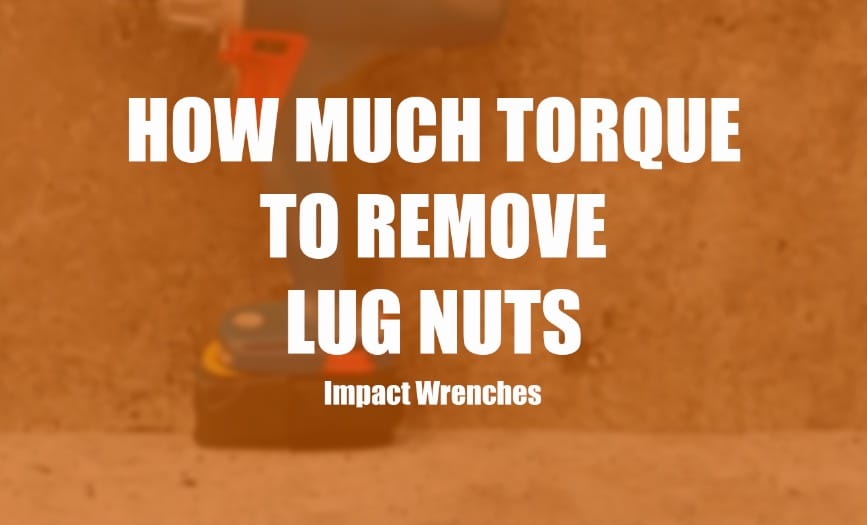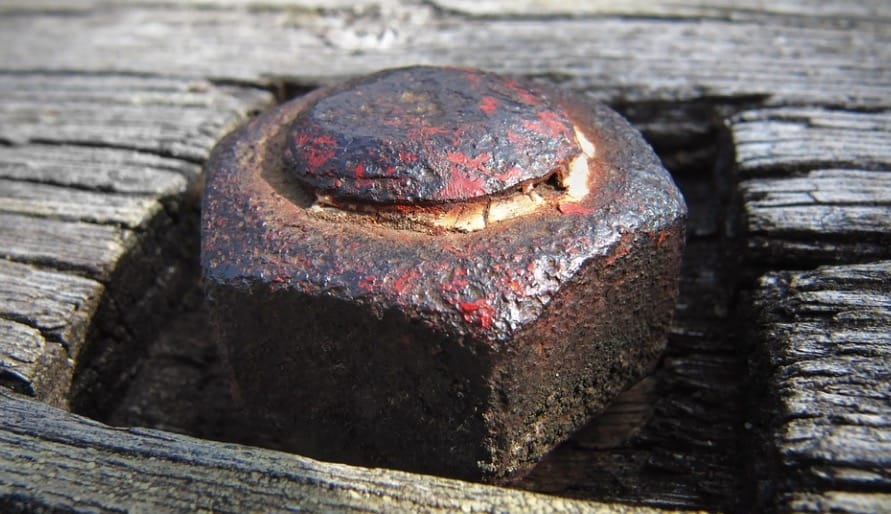If you have ever tried to remove lug nuts from your car’s wheels, you know it can be quite a challenge as lug nuts can become stubborn, making it difficult to remove them, even with the right tools.
In this article, we will explore some of the challenges involved in removing lug nuts and provide some useful tips on how much torque you need to remove lug nuts.
We will discuss the different torque levels needed for various types of lug nuts, the importance of following factory-recommended torque specifications, and the best tools for removing lug nuts.
Let’s get on with it.
Challenges in Lug Nut Removal
You’d think removing lug nuts would be as easy as pie, but sometimes that doesn’t happen. This can happen for various reasons, but sometimes those lug nuts cling to your wheels like a dog with a chew toy.
Here’s what could make your lug nuts very hard to remove:
- Over-tightening: Picture this: some overzealous auto shop mechanic cranks those lug nuts way too tight during a tire change. Now you’re stuck with lug nuts that need a whole lot more torque to remove, making your life a living nightmare.
- Dirt and rust: Oh, and let’s not forget about our good friend, Mother Nature. Dirt and rust can creep in and mess with the removal torque, adding a hefty 50 to 200 lbs of breakaway torque needed to remove these fasteners
- Cross-threading: Cross-threading occurs when the lug nut is improperly threaded onto the wheel stud, causing the threads to become misaligned. Loosening or removing that lug nut becomes a real challenge, and you risk doing some serious damage to both the lug nut and the wheel stud in the process.
How Much Torque to Remove Lug Nuts
It’s time to get down to business and figure out how much torque you actually need to remove those pesky lug nuts.
So, let’s dive into the nitty-gritty of different lug nuts and the estimated torque levels you’ll need to remove them:
- Standard car lug nuts (new or in tip-top shape): You’ll need about 80-100 ft-lbs.
- Standard truck or SUV lug nuts (also in mint condition): 120-150 ft-lbs – they’re a bit tougher but still manageable.
- Rusty or corroded lug nuts: Add an extra 50-200 ft-lbs to the standard torque level, depending on how much rust and corrosion is present.
- Over-tightened lug nuts: The required torque for removal may be 20-50% higher than what the manufacturer suggests.
- Cross-threaded lug nuts: The required torque for removal varies wildly. You’ll need extreme caution, penetrating oil, and maybe even a Hail Mary to avoid damaging the threads further.
Remember, these values are ballpark figures, as actual factory recommended torque specifications (which we will talk about right below) can vary a lot.
Factory Recommended Torque Specifications
Following the “Factory-Recommended Torque Specifications” should make your life easier when removing lug nuts, as they should let you know the exact level of torque needed to remove a particular lug nut.
Sadly, these specifications are not followed by mechanics and other tradesmen, which is why it’s very important for me to teach you about their importance:
- Importance: You better believe that straying from the factory-recommended specs can lead to a whole bunch of problems, like damaged lug nuts and tools.
- Warranty coverage: By the way, following torque specifications helps maintain warranty coverage on new vehicles. So, don’t go rogue, folks – your wallet will thank you.
- Proper stress distribution: Another critical reason for adhering to Factory Recommended Torque Specifications for lug nuts is maintaining proper stress distribution. When you follow the torque specs, you’re ensuring that the clamping force is evenly distributed, like a perfectly balanced see-saw. This prevents uneven pressure on your wheels, suspension, and braking system, reducing the risk of premature wear or even component failure.
Choosing the Right Tools for Lug Nut Removal
So, you’ve got a better understanding of the challenges and the torque needed for lug nut removal.
But, that knowledge won’t get you far without the proper tools (e.g. impact wrench). You’ll need to arm yourself with the right equipment to tackle those stubborn lug nuts with finesse.
So let’s dive into the world of lug nut removal tools and find out what you need to get the job done right:
- High breakaway torque impact wrench: This tool is the MVP of lug nut removal. The power hitter will get you through even the toughest jobs without breaking a sweat.
- Breaker bar: When you need some extra leverage to loosen those stubborn lug nuts, a breaker bar uses its extended handle to multiply the force you apply, turning it into a torque powerhouse that can break the lug nuts free
- Lug wrench: The classic lug wrench, also known as the tire iron, is the tried-and-true method for removing lug nuts. It may not be as fancy as an impact wrench, but it’ll get the job done.
What Tools to Measure Torque?
So, you’re ready to remove those lug nuts, and you want to make sure you’re applying the right amount of force and you need a trusty tool to measure torque accurately.
Otherwise, you run the risk of stripping the threads, warping the brake rotors, or even having a wheel come loose while driving, which is a terrifying prospect that we all want to avoid.
I’ve got you covered with the top torque-measuring instruments that’ll make this possible:
- Torque Wrench: The torque wrench allows you to set the desired amount of force (measured in ft-lbs or Nm) and then alerts you, often with a satisfying “click,” when you’ve reached that level. You can use this tool by slowly tightening the lug nut, applying steady pressure until you hear the click. That’s when you know you’ve hit the sweet spot.
- Torque Stick: This handy little device is used in combination with your trusty impact wrench. They are color-coded, and each corresponds to a specific torque value. You simply attach the correct torque stick to your impact wrench, and it will limit the torque applied to the lug nuts, which is a convenient way to ensure you’re in the ballpark when it comes to torque.
- Torque Adapter: A torque adapter is a compact, portable device that can turn your regular ratchet wrench into a torque-measuring powerhouse. Simply attach the adapter between your ratchet and socket, and it will provide you with real-time torque readings as you tighten or loosen lug nuts.
Tips for Removing Lug Nuts Safely and Effectively
Now that you’ve got the right tools in your arsenal, it’s time to learn some tricks of the trade.
Let me share with you some tips that’ll make removing lug nuts a walk in the park, instead of a never-ending battle:
- Avoid over-tightening: When installing lug nuts, use a torque wrench set to the manufacturer’s recommended value. This will save you from the heartache of trying to remove over-tightened lug nuts later on.
- Applying the right amount of torque: When removing lug nuts, use a little penetrating oil to loosen them up, and gradually increase force as needed. This way, you’re less likely to strip the lug nuts or damage the threads.
- Regular maintenance and cleaning: Keep rust and dirt at bay by regularly cleaning and maintaining your lug nuts. This will make removal a breeze and ensure your vehicle stays in tip-top shape.
Frequently Asked Questions
Can I use an impact wrench to remove lug nuts?
Absolutely! In fact, an impact wrench is one of the best tools for removing lug nuts.
These powerful devices use rapid bursts of torque to quickly and efficiently loosen even the most stubborn lug nuts.
However, it’s important to choose an impact wrench with a high breakaway torque rating and to use it responsibly.
As we’ve already seen, over-torquing lug nuts with an impact wrench can cause damage to the wheel studs or lug nuts themselves.
Will a 12 volt impact wrench remove lug nuts?
Generally, 12-volt impact wrenches are less powerful than their 18-volt or 20-volt counterparts.
For most passenger vehicles, a 12-volt impact wrench with a torque rating of around 100 ft-lbs should be sufficient.
However, for larger vehicles such as trucks or SUVs with higher torque requirements, you might need a more powerful impact wrench to get the job done.
What tool is best for removing lug nuts?
There are several tools that can be used for removing lug nuts, each with its own set of advantages:
- Impact wrench: As mentioned earlier, impact wrenches are the top choice for removing lug nuts due to their high breakaway torque and efficiency. They quickly loosen lug nuts and are especially useful for professional mechanics or those who frequently change tires.
- Torque wrench: A torque wrench is a versatile tool that can both tighten and loosen lug nuts. It is particularly useful for ensuring the correct torque is applied when tightening lug nuts, preventing over-tightening or under-tightening.
- Breaker bar: A breaker bar is an excellent choice for those who need extra leverage to remove stubborn or rusted lug nuts. Its long handle and durable construction make it a reliable option for breaking loose stuck lug nuts.
- Lug wrench: Also known as a tire iron, this is the classic tool for removing lug nuts. It’s simple, portable, and gets the job done, but it may require more physical effort than other tools.
Ultimately, the best tool for removing lug nuts depends on your specific needs, the condition of the lug nuts, and your personal preferences.
However, impact wrenches are generally considered the go-to choice for efficient lug nut removal.


